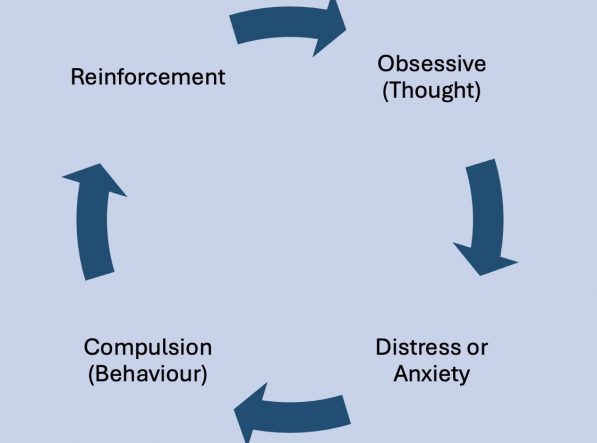Working with OCD
Breaking the OCD Cycle
The Cycle of OCD looks like this...

OCD is not just about anxiety - and it can be a debilitating and frightening problem. However, support is here and recovery is absolutely possible. Here are some of my thoughts about the condition, and some strategies I have found work to help ease the symptoms, intrusive thoughts, obsessions and compulsions.
It is not uncommon for children to go through a phase of needing certain things to be 'just so', symmetrical, clean, or ordered. This in itself may not be a problem and many children grow out of compulsive bahaviour without having to work too hard at it. With normal development they may learn to let go of obsessions and manage intrusive thoughts without needing compulsive behaviour to soothe. However, when obsessions are overwhelming, and compulsions become impairing and interfer with day to day life, it is worth challenging the obsessions, retraining the brain, and learning how to to stop the compulsive behaviour. If compulsions are mixed up with food and eating rules, this can lead to eating problems and an eating disorder, which is obviously serious.
I start by compassionately getting to know my client, and identifying all the symptoms and the 'type' of OCD the individual has. It can be affirming to know you are not the only one with these thoughts and compulsions. Most recently hand washing has become a common compulsion, following the fear of contamination and passing on germs during the pandemic. There are various tools I can use to properly assess the extent of the problem, how impairing it is, and to get to know the indiviual's unique condition.
We can attempt to break the OCD cycle in three places; crucially we try to consider the brain and mind as separate, with 'you', the observer, watching how the mind responds to the infomation it receives from the brain.
We may start by exploring and getting curious about where the obsessive thoughts have originated. Or perhaps they are merely intrusive thoughts that come and go. They may be well grounded and logical, based on reality, but have become distorted. By naming and then gently challenging these cognitive distortions a client will begin to distance themself from the thoughts. A better understanding of the origins can be helpful, but equally just becomming sceptical through Socratic Quesioning can be reassuring.
All of us can also learn to manage anxiety and tolerate distress. There are so many ways to help someone widen their window of tolerance and manage the physical feelings of anxiety. We might do this with bottom up approaches to calm the brain down, such as breathwork, grounding techniques, meditation, exercise, good nutrition and by considering self-care. An OCD sufferer may need to become curious about how their body responds to the trigger and obsession and learn new ways to tolerate and then let go of the anxiety that comes. Mindfulness and being present in the here and now is an important skill. Space and calm might allow the mind to react differently to the infomation it receives, thus rewiring the brain.
We deal with compulsions using exposure response prevention (ERP). This is a way to gently and gradually expose the sufferer to their triggers, and learn how to delay and ultimately stop the compulsions. This is not as simple as it sounds, and takes compassion, patience and time from the client, those around them and the therapist. Together we may look at a hierarchy of compulsions that the sufferer wants to lose, and we simply start at the bottom and work our way up. Recovery is rarely linear, and of course life is unpredictable. Learning to tolerate uncertainty is a big part of treatment.
If you or your child is suffering from intrusive thoughts, obsessions and compulsive behaviour, there is help available, and early intervention is always best.
© Katie Perryman
powered by WebHealer